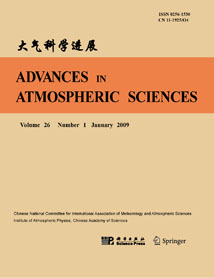| [1] |
Zhou Xiuji, Qiu Jinhuan,
1984: CHARACTERISTICS OF ATMOSPHERIC EXTINCTION-TO-BACKSCATTERING RATIO IN RUBY LIDAR MEASUREMENTS, ADVANCES IN ATMOSPHERIC SCIENCES, 1, 179-198.
doi: 10.1007/BF02678130
|
| [2] |
Peipei YU, Chunxiang SHI, Ling YANG, Shuai SHAN,
2020: A New Temperature Channel Selection Method Based on Singular Spectrum Analysis for Retrieving Atmospheric Temperature Profiles from FY-4A/GIIRS, ADVANCES IN ATMOSPHERIC SCIENCES, 37, 735-750.
doi: 10.1007/s00376-020-9249-9
|
| [3] |
Xiaojuan SUN, Siyan LI, Julian X. L WANG, Panxing WANG, Dong GUO,
2022: A New Method of Significance Testing for Correlation-Coefficient Fields and Its Application, ADVANCES IN ATMOSPHERIC SCIENCES, 39, 529-535.
doi: 10.1007/s00376-021-1196-6
|
| [4] |
Qiu Jinhuan, Wang Hongqi, Zhou Xiuji, Lu Daren,
1985: EXPERIMENTAL STUDY OF REMOTE SENSING OF ATMOSPHERIC AEROSOL SIZE DISTRIBUTION BY COMBINED SOLAR EXTINCTION AND FORWARD SCATTERING METHOD, ADVANCES IN ATMOSPHERIC SCIENCES, 2, 307-315.
doi: 10.1007/BF02677246
|
| [5] |
ZHONG Lingzhi, LIU Liping, DENG Min, ZHOU Xiuji,
2012: Retrieving Microphysical Properties and Air Motion of Cirrus Clouds Based on the Doppler Moments Method Using Cloud Radar, ADVANCES IN ATMOSPHERIC SCIENCES, 29, 611-622.
doi: 10.1007/s00376-011-0112-x
|
| [6] |
Wu Beiying, Lu Daren,
1985: REMOTE SENSING OF RAINFALL PARAMETERS BY LASER SCINTILLATION CORRELATION METHOD -NUMERICAL SIMULATION OF THE RETRIEVING, ADVANCES IN ATMOSPHERIC SCIENCES, 2, 325-333.
doi: 10.1007/BF02677248
|
| [7] |
Zeng Xinmin, Zhao Ming, Su Bingkai,
2000: A Numerical Study on Effects of Land-Surface Heterogeneity from “Combined Approach” on Atmospheric Process Part I: Principle and Method, ADVANCES IN ATMOSPHERIC SCIENCES, 17, 103-120.
doi: 10.1007/s00376-000-0047-0
|
| [8] |
Shen YAN, Jie XIANG, Huadong DU,
2019: Determining Atmospheric Boundary Layer Height with the Numerical Differentiation Method Using Bending Angle Data from COSMIC, ADVANCES IN ATMOSPHERIC SCIENCES, 36, 303-312.
doi: 10.1007/s00376-018-7308-2
|
| [9] |
XU Dongmei, Thomas AULIGNÈ, Xiang-Yu HUANG,
2015: A Validation of the Multivariate and Minimum Residual Method for Cloud Retrieval Using Radiance from Multiple Satellites, ADVANCES IN ATMOSPHERIC SCIENCES, 32, 349-362.
doi: 10.1007/s00376-014-3258-5
|
| [10] |
Li Jun, Zhou Fengxian,
1992: On Accurate Detection of Oceanic Features from Satellite IR Data Using ICSED Method, ADVANCES IN ATMOSPHERIC SCIENCES, 9, 373-382.
doi: 10.1007/BF02656948
|
| [11] |
Wang Bin, Ji Zhongzhen,
1993: An Improved Splitting Method, ADVANCES IN ATMOSPHERIC SCIENCES, 10, 447-452.
doi: 10.1007/BF02656969
|
| [12] |
Liu Guifu,
1996: Introduction to an Invariant Quantity Method, ADVANCES IN ATMOSPHERIC SCIENCES, 13, 59-66.
doi: 10.1007/BF02657028
|
| [13] |
YAO Zhigang, CHEN Hongbin, LIN Longfu,
2005: Retrieving Atmospheric Temperature Profiles from AMSU-A Data with Neural Networks, ADVANCES IN ATMOSPHERIC SCIENCES, 22, 606-616.
doi: 10.1007/BF02918492
|
| [14] |
Chenbin XUE, Zhiying DING, Xinyong SHEN, Xian CHEN,
2022: Three-Dimensional Wind Field Retrieved from Dual-Doppler Radar Based on a Variational Method: Refinement of Vertical Velocity Estimates, ADVANCES IN ATMOSPHERIC SCIENCES, 39, 145-160.
doi: 10.1007/s00376-021-1035-9
|
| [15] |
Xuechun LUO, Xiao TANG, Haoyue WANG, Lei KONG, Huangjian WU, Weiguo WANG, Yating SONG, Hongyan LUO, Yao WANG, Jiang ZHU, Zifa WANG,
2023: Investigating the Changes in Air Pollutant Emissions over the Beijing-Tianjin-Hebei Region in February from 2014 to 2019 through an Inverse Emission Method, ADVANCES IN ATMOSPHERIC SCIENCES, 40, 601-618.
doi: 10.1007/s00376-022-2039-9
|
| [16] |
Fang Yuan, Zijiang Zhou, LIAO Jie,
2024: A New method for deriving the high-vertical-resolution Wind Vector data from L-band radar sounding system in China, ADVANCES IN ATMOSPHERIC SCIENCES.
doi: 10.1007/s00376-024-3163-5
|
| [17] |
LI Nan, WEI Ming, TANG Xiaowen, PAN Yujie,
2007: An Improved Velocity Volume Processing Method, ADVANCES IN ATMOSPHERIC SCIENCES, 24, 893-906.
doi: 10.1007/s00376-007-0893-0
|
| [18] |
Xu Hong, Li Hongji, Wang Ronghua,
1989: A Numerical Method of Statistical Pattern Recognition, ADVANCES IN ATMOSPHERIC SCIENCES, 6, 483-492.
doi: 10.1007/BF02659082
|
| [19] |
Ji Zhongzhen, Wang Bin,
1997: Multispectrum Method and the Computation of Vapor Equation, ADVANCES IN ATMOSPHERIC SCIENCES, 14, 563-568.
doi: 10.1007/s00376-997-0074-1
|
| [20] |
HUO Yanfeng, DUAN Minzheng, TIAN Wenshou, MIN Qilong,
2015: A Differential Optical Absorption Spectroscopy Method for X CO2 Retrieval from Ground-Based Fourier Transform Spectrometers Measurements of the Direct Solar Beam, ADVANCES IN ATMOSPHERIC SCIENCES, 32, 1119-1128.
doi: 10.1007/s00376-015-4213-9
|















 AAS Website
AAS Website 
 AAS WeChat
AAS WeChat 
 DownLoad:
DownLoad: